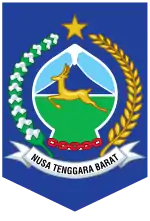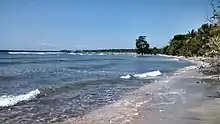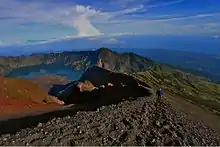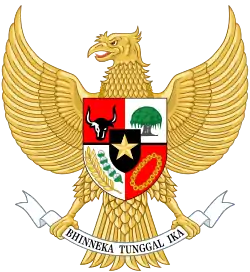West Nusa Tenggara
West Nusa Tenggara (Indonesian: Nusa Tenggara Barat – NTB) is a province of Indonesia. It comprises the western portion of the Lesser Sunda Islands, with the exception of Bali which is its own province. Mataram, on Lombok, is the capital and largest city of the province. The 2010 census recorded the population at 4,500,212; the total rose to 4,830,118 at the 2015 Census; the latest official estimates are 5,070,385 for mid 2019 and 5,125,622 for mid 2020.[5] The province's area is 20,153.15 km2. The two largest islands in the province are Lombok in the west and the larger Sumbawa island in the east.
West Nusa Tenggara | |
|---|---|
 Flag  Coat of arms | |
 Location of West Nusa Tenggara in Indonesia | |
| Coordinates: 8°35′S 116°7′E | |
| Established | 14 August 1958[1] |
| Capital and largest city | Mataram |
| Government | |
| • Body | West Nusa Tenggara Provincial Government |
| • Governor | Zulkieflimansyah |
| • Vice Governor | Sitti Rohmi Djalilah |
| Area | |
| • Total | 20,153.15 km2 (7,781.17 sq mi) |
| Area rank | 25th |
| Highest elevation | 3,726 m (12,224 ft) |
| Population (mid 2020 Estimate)[2] | |
| • Total | 5,125,622 |
| • Rank | 13th |
| • Density | 250/km2 (660/sq mi) |
| Demographics | |
| • Ethnic groups[3] | 68% Sasak 14% Bimese 8% Sumbawa 3% Balinese 3% Dompuan 2% Javanese |
| • Religion[4] | 96% Islam 3% Hinduism 1% Buddhism |
| • Languages | Indonesian (official) |
| Time zone | UTC+8 (Indonesia Central Time) |
| ISO 3166 code | ID-NB |
| HDI | |
| HDI rank | 29th (2019) |
| Website | ntbprov.go.id |
History
Pre-Islamic period
Based on analysis of prehistoric objects found (such as complex sarcophagi, decorated stoneware, machetes, and axes), West Nusa Tenggara had previously been inhabited by people who come from Southeast Asia.
The natives in this region are called the Sasak people, most of whom live on the island of Lombok. Meanwhile, on the island of Sumbawa are also natives consisting of two groups, namely ethnic Sumbawa (Samawa) and Bima. However, with the wave of migrants from Bali, Makassar, Java, Kalimantan, Nusa Tenggara, Maluku and East Nusa Tenggara, the indigenous people entered the farm and then stay in the interior.
The existence of this region can not be separated from the heyday of Majapahit Empire in the 14th century who conquered all the kingdoms located on the islands of both Lombok and Sumbawa. In the book Negarakertagama by Empu Prapanca in 1365, it was written that West Lombok was named Lombok Mirah and East Lombok was named Sasak Adi, Taliwang, Dompo (Dompu), Sape, Sanghyang Fire, Bhima (Bima), Seram (Seran) and Hutan Kedali (Utan).[6]
Islamic period
In the early reign of the kings in West Nusa Tenggara, the influence of Hinduism was very strong. It can not be separated from the influence of the Majapahit empire expansion into the region. But with the collapse of the Majapahit kingdom, the influence of Hinduism began to decrease with the onset of the influence of Islam in the coastal communities.
The advent of the Demak Sultanate in Central Java had a huge impact on the spread of the teachings of Islam in West Nusa Tenggara. The influence of Islam in West Nusa Tenggara was generally brought by the Malays. The influence of Islam in Bima can not be separated from the support of King I Maliingkaang Daeng-Mannyonriq of Makassar, who was then known as Karaeng Matoaya who played an important role in the spread of Islam in the region.
The influence of Islam in the Bima Sultanate emerged in the reign of King Manuru Salehi around 1605 and began to grow rapidly during the reign of King Abdul Kahir . King Abdul Kahir is also known as the Sultan of Bima I, because he was the king who first embraced Islam in Bima, so it is considered a new era, separate from the previous Bima king who embraced Hinduism. Islam became the official religion of the kings in West Nusa Tenggara.[7]
Colonial period
The Europeans who first came to the land of Nusa Tenggara were the Portuguese who landed on the island of Solor and Timor in 1605. At the same time the Dutch also came to the island of Hitu and Ambon, in the Malukus. The first Dutch ship that entered the area was the Ter Ver which docked in Kupang in 1611. The arrival of the Dutch led to a long dispute between the Portuguese and the Dutch in Nusa Tenggara. The Dutch provided assistance to the local kings who resisted the Portuguese. The Netherlands then expanded its influence in Nusa Tenggara, to make a variety of agreements with small kings around the island of Sumbawa.
The penetration of the Dutch colonial administration that was so strong in Indonesia was increasingly bringing real impact to the survival of Indonesian society in general. One result was very broad: in the eastern part of Indonesia, the Sultanate of Gowa began to decline in its supremacy in the 17th century. Gowa nobility who did not submit to the colonial government fled from Makassar and built pockets of resistance in West Nusa Tenggara. To face such resistance, the colonial government began to concentrate power in West Nusa Tenggara. This was reinforced by the emergence of Lombok for international trade traffic, so the desire of the Dutch to rule West Nusa Tenggara directly become apparent.
Faced with such a situation, the Dutch colonial government sent Stephen van Hegen for a close look at the Bima situation in 1660. The arrival of the Dutch influenced the political and economic situation in this area. In 1669, the Government of the Kingdom of Bima led by Sultan Ambela Abdul Khair Sirajuddin, made peace and friendship ties with the colonial government with the contents of the agreement as follows:
- The Sultanate of Bima and Dompu will not attack Makassar
- To keep the peace, only members of the Dutch East India Company may visit the Bima area
- Bima and Makassar will not make any contact at all.
- Foreign traders from Europe, India, Java, Malaya, Arab lands, Aceh, and Champa must not engage in trade with Bima, except by special permit from the Dutch East India Company.
The agreement with the Sultan of Bima and Dompu recognized the existence of the Dutch colonial power. Since then, the Netherlands sought to consolidate its control by blocking the Bima port to prevent the arrival of aid from Makassar or other foreign countries. The effort was done so that the existing ports in Bima and Lombok Island were considered to be strategic, and not fall into British hands.
The Dutch supremacy in the region was very strong, so the king and the people in the region could not move freely. This condition became worse with the eruption of Mount Tambora on April 5, 1815, which shook the entire region, and the consequences could be felt throughout the Moluccas, Java, Sulawesi, Sumatra, and Kalimantan. Mount Tambora's eruption resulted in the disappearance of the two kingdoms of Tambora and Papekat. More than 10,000 people were killed.
Independence
The existence of the status of the province West Nusa Tenggara did not come by itself. The struggle demanded that the formation of West Nusa Tenggara province take place over quite a long time. West Nusa Tenggara province previously had been part of the State of East Indonesia in the conception of the Republic of Indonesia States, and be part of the small Sunda province after recognition of Indonesian sovereignty.
Along with the dynamics and after some time, the process of changing the constitutional system after the proclamation of the Independence of the Republic of Indonesia then formed the province of West Nusa Tenggara. With the enactment of Law No. 64 of 1958 Date August 14, 1958 on the Establishment of Regions Autonomous of Bali, West Nusa Tenggara and East Nusa Tenggara, the province was officially established and the first Governor of the province was AR. Moh. Ruslan Djakraningrat.
Geography

Terrain
West Nusa Tenggara has two kinds of landscape. The first is the island of Lombok with the coastline fairly straight, with the central to eastern part in the form of mountains, and coastal lowlands in the east. The second is Sumbawa Island with a jagged coastline because of the many headlands and bays, and the central part is covered with hills and limestone mountains.
Selong (capital of East Lombok Regency) is a city that has the highest altitude, which is 148 m above sea level, while the lowest Raba at 13 m above sea level. Of the seven mountains on the island of Lombok, Mount Rinjani is the highest mountain with an altitude of 3,775 m, while Mount Tambora on Sumbawa is the highest mountain with an altitude of 2,851 m.
Climate
Like the rest of Indonesia, NTB has a tropical climate. Based on statistics from the meteorological institute, the maximum temperature in 2001 ranged from 30.9 to 32.1 °C and minimum temperature ranged between 20.6 and 24.5 °C. The highest temperatures occur in September and the lowest are in November. Being tropical, NTB has a high average relative humidity, which is between 48 and 95%.
West Nusa Tenggara has relatively little rainfall compared to the western region of Indonesia. Maximum rainfall in the province occurs in January and minimum rainfall occurs in August.
Economy
The area of West Nusa Tenggara (NTB) has very beautiful natural scenery, be it the mountains or the beach. This has caused many tourists from other parts of Indonesia and other countries to flock to the province due to its stunning scenery.
In addition to the panorama of beautiful tourist attractions, food crops and horticulture developed and cultivated by the community that are profitable for farmers, among others, are: soybeans, peanuts, corn, green beans, peppers, onions, mangoes, bananas and pineapples. In addition to the nine kinds of commodities in the regions, other horticultural commodities that can be developed are potatoes, carrots, apples, and grapes.
As for fisheries, NTB has 3 areas of fisheries development:
- The island of Lombok, with a priority on the development of marine aquaculture and freshwater fisheries, brackish water aquaculture (ponds), catching public waters;
- The western part of Sumbawa Island, priority on the development of brackish water aquaculture (ponds), mariculture, arrest, public waters and freshwater aquaculture;
- Eastern part of Sumbawa Island with priority on the development of catching, mariculture, public waters, and freshwater aquaculture.
West Nusa Tenggara is one of the major manufacturers and suppliers of livestock and seeds to the needs of various regions in Indonesia. The carrying capacity of livestock-based agribusiness development, among others, the potential availability of cattle in quality and quantity, land resources, and fodder, support all production, pet patterns as a group, are non communicable diseases as well as the bank still has domestic and export markets. The NTB cow is a kind of Bali cattle, which is a leading NTB commodity and has domestic and export markets. In addition to cows and buffaloes, other supporting commodities are pigs, goats and horses, chickens, and ducks.
Administration
The province is administratively divided into eight regencies (kabupaten) and two municipalities (kotamadya), listed below with their areas and their populations at the 2010 Census[8] and 2015 Intermediate Census, together with the official estimates for mid 2019.[9]
| Name | Capital | Area (km²) | Population 2010 Census | Population 2015 Census | Population mid 2019 Estimate | HDI[10] 2014 Estimates |
|---|---|---|---|---|---|---|
| Mataram City | 61.30 | 402,843 | 449,438 | 486,715 | 0.759 (High) | |
| Central Lombok Regency (Lombok Tengah) | Praya | 1,208.40 | 860,209 | 911,997 | 947,488 | 0.618 (Medium) |
| East Lombok Regency (Lombok Timur) | Selong | 1,605.55 | 1,105,582 | 1,163,161 | 1,200,612 | 0.620 (Medium) |
| North Lombok Regency (Lombok Utara) | Tanjung | 809.53 | 200,072 | 212,023 | 220,412 | 0.601 (Medium) |
| West Lombok Regency (Lombok Barat) | Gerung | 1,053.87 | 599,986 | 654,008 | 694,985 | 0.635 (Medium) |
| Total Lombok | 4,738.65 | 3,168,692 | 3,390,627 | 3,550,212 | ||
| Bima City | Bima | 207.50 | 142,579 | 159,445 | 173,031 | 0.722 (High) |
| Bima Regency | Woha | 4,389.40 | 439,228 | 468,201 | 488,577 | 0.626 (Medium) |
| Dompu Regency | Dompu | 2,324.60 | 218,973 | 238,061 | 252,288 | 0.635 (Medium) |
| Sumbawa Regency | Sumbawa Besar | 6,643.98 | 415,789 | 440,730 | 457,671 | 0.628 (Medium) |
| West Sumbawa Regency (Sumbawa Barat) | Taliwang | 1,849.02 | 114,951 | 133,054 | 148,606 | 0.671 (Medium) |
| Total Sumbawa | 15,414.50 | 1,331,520 | 1,439,491 | 1,520,173 |
The Indonesian Government is currently considering the division of Nusu Tenggara Barat Province to create a separate Sumbawa Island province.[11] There is no information as to whether the remaining part of the present province (i.e. the districts comprising Lombok Island) would then be renamed.
Population
| Year | Pop. | ±% |
|---|---|---|
| 1971 | 2,203,465 | — |
| 1980 | 2,724,664 | +23.7% |
| 1990 | 3,369,649 | +23.7% |
| 1995 | 3,645,713 | +8.2% |
| 2000 | 4,009,261 | +10.0% |
| 2005 | 4,184,411 | +4.4% |
| 2010 | 4,500,212 | +7.5% |
| 2015 | 4,830,118 | +7.3% |
| 2019 | 5,070,385 | +5.0% |
| Source: Statistics Indonesia 2019 | ||
Lombok is mainly inhabited by the Sasak ethnic group, with a minority Balinese population, and Sumbawa is inhabited by Sumbawa and Bima ethnic groups. Each of these groups has a local language associated with it as well. The population of the province was 4.5 million (at the 2010 census) and 4.83 million at the 2015 Census; the latest official estimate (for mid 2020) is 5,125,622.[12] 70.0% of the population lives on Lombok (at the 2015 census), which has only 23.5% of the area. The province is considered to be one of the least developed of Indonesia's 34 provinces. In 2005, Nusa Tenggara Barat was reported as the most affected area for malnutrition and kwashiorkor.[13] Life expectancy in Nusa Tenggara Barat amounting to only 54 years is the lowest in Indonesia (69 years) and infant mortality rate is the highest.[14]
Religion
References
- "J.D.I.H. - Dewan Perwakilan Rakyat".
- Badan Pusat Statistik, Jakarta, 2020.
- Indonesia's Population: Ethnicity and Religion in a Changing Political Landscape. Institute of Southeast Asian Studies. 2003.
- Badan Pusat Statistik, Jakarta, 2020.
- Sejarah Nusa Tenggara Barat Periode Kerajaan
- Sejarah Nusa Tenggara Barat Periode Awal Perkembangan Islam
- Biro Pusat Statistik, Jakarta, 2011.
- Badan Pusat Statistik, Jakarta, 2020.
- Indeks-Pembangunan-Manusia-2014
- Officials support new province for Sumbawa | The Jakarta Post
- Badan Pusat Statistik, Jakarta, 2020.
- Ragil Suwito: Geography 2, p.151. Jakarta Timur 2010. ISBN 978-979-019-896-8
- Ragil Suwito: Geography 2, p.149. Jakarta Timur 2010. ISBN 978-979-019-896-8
- "Population by Region and Religion in Indonesia". BPS. 2010.
External links
| Wikivoyage has a travel guide for West Nusa Tenggara. |
 Media related to West Nusa Tenggara at Wikimedia Commons
Media related to West Nusa Tenggara at Wikimedia Commons- Official website

